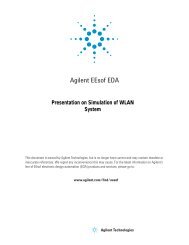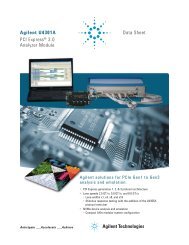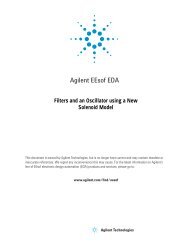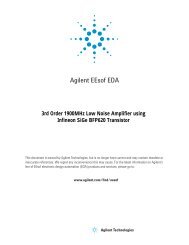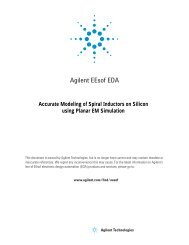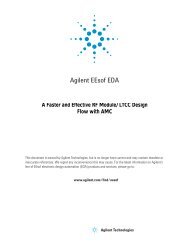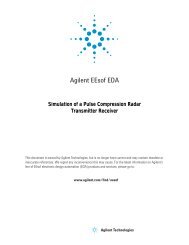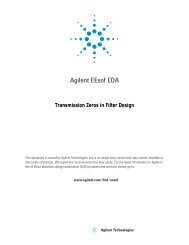Agilent 34980A Multifunction Switch/Measure Unit *34980-90005*
Agilent 34980A Multifunction Switch/Measure Unit *34980-90005*
Agilent 34980A Multifunction Switch/Measure Unit *34980-90005*
Create successful ePaper yourself
Turn your PDF publications into a flip-book with our unique Google optimized e-Paper software.
1 Introduction to the <strong>34980A</strong><br />
Signal Routing and <strong>Switch</strong>ing<br />
The switching capabilities of the plug- in modules available with the<br />
<strong>34980A</strong> provide test system flexibility and expandability. You can use the<br />
switching plug- in modules to route signals to and from your test system<br />
or multiplex signals to the internal DMM or external instruments.<br />
Relays are electromechanical devices which are subject to wear- out<br />
failure modes. The life of a relay, or the number of actual operations<br />
before failure, is dependent upon how the relay is used—applied load,<br />
switching frequency, and environment. The <strong>34980A</strong> Relay Maintenance<br />
System automatically counts the cycles of each relay in the instrument<br />
and stores the total count in non- volatile memory on each switch<br />
module. You can use this feature to track relay failures and to predict<br />
system maintenance requirements. For more information on using this<br />
feature, refer to “Relay Cycle Count” on page 154.<br />
<strong>Switch</strong>ing Topologies<br />
Several switching plug- in modules are available with different topologies<br />
for various applications. The following switching topologies are available:<br />
Multiplexer (with armature, reed, or FET switches)<br />
Matrices (with armature or reed switches )<br />
General Purpose (with Form C or Form A switches)<br />
The following sections describe each of these switching topologies. For<br />
more information, see the individual User's Guides included with each<br />
module.<br />
Multiplexer <strong>Switch</strong>ing<br />
Multiplexers allow you to connect one of multiple channels to a common<br />
channel, one at a time. A simple 4- to- 1 multiplexer is shown below.<br />
Multiplexers are available in several types:<br />
One- Wire (Single- Ended) Multiplexers for common LO measurements<br />
Two- Wire Multiplexers for floating measurements<br />
Channel 1<br />
Common Channel 2<br />
Channel 3<br />
Channel 4<br />
Four- Wire Multiplexers for resistance and RTD measurements<br />
Very High Frequency (VHF) Multiplexers for switching frequencies up<br />
to 3 GHz.<br />
When you combine a multiplexer with a measurement device, like the<br />
optional internal DMM, you create a scanner. For more information on<br />
scanning, see “Scanning” on page 13.<br />
8 <strong>Agilent</strong> <strong>34980A</strong> Mainframe User’s Guide





